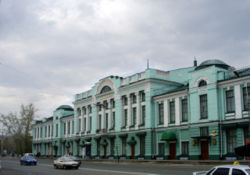HOMEPAGE
LOCATION AND CLIMATE
HISTORY
LANDMARKS
FEEDBACK
|
The centrepiece of the city is an ensemble of buildings along Lyubinsky
pro spekt/Lenin Street. This is the former Gostiny Dvor, flanked by two chapels.
Close at hand are a bourse and a drama theater, all dating from late 1800s ¢
early 1900s. Side streets are lined with stately mansions of former insurance
companies, trusts and banks from the same period. Hidden closer to the river
confluence are the few surviving somber buildings of the 18th-century fortress.
The largest and most opulent church in the city is the Dormition Cathedral, a
pompous five-domed edifice in the Russian Revival style, consecrated in 1896,
blown up by the Soviets, and meticulously restored in the early 2000s. Another
area of interest is Nikolsky prospekt/Krasnykh Zor Street, where a line of
merchants' wooden houses still stands. The street leads to the Neoclassical
cathedral of St Nicholas, which was commissioned by the Cossacks, designed by
Vasily Stasov and consecrated in 1840. It contains various relics of the
Siberian Cossacks. Various other landmarks are scattered throughout the city.
The major museums in Omsk are the Omsk Vrubel Art Gallery and the State
Historical Museum, located in the former bourse building and the
governor-general's mansion, respectively.
spekt/Lenin Street. This is the former Gostiny Dvor, flanked by two chapels.
Close at hand are a bourse and a drama theater, all dating from late 1800s ¢
early 1900s. Side streets are lined with stately mansions of former insurance
companies, trusts and banks from the same period. Hidden closer to the river
confluence are the few surviving somber buildings of the 18th-century fortress.
The largest and most opulent church in the city is the Dormition Cathedral, a
pompous five-domed edifice in the Russian Revival style, consecrated in 1896,
blown up by the Soviets, and meticulously restored in the early 2000s. Another
area of interest is Nikolsky prospekt/Krasnykh Zor Street, where a line of
merchants' wooden houses still stands. The street leads to the Neoclassical
cathedral of St Nicholas, which was commissioned by the Cossacks, designed by
Vasily Stasov and consecrated in 1840. It contains various relics of the
Siberian Cossacks. Various other landmarks are scattered throughout the city.
The major museums in Omsk are the Omsk Vrubel Art Gallery and the State
Historical Museum, located in the former bourse building and the
governor-general's mansion, respectively.
|
